#Syncretic Practice
Explore tagged Tumblr posts
Text
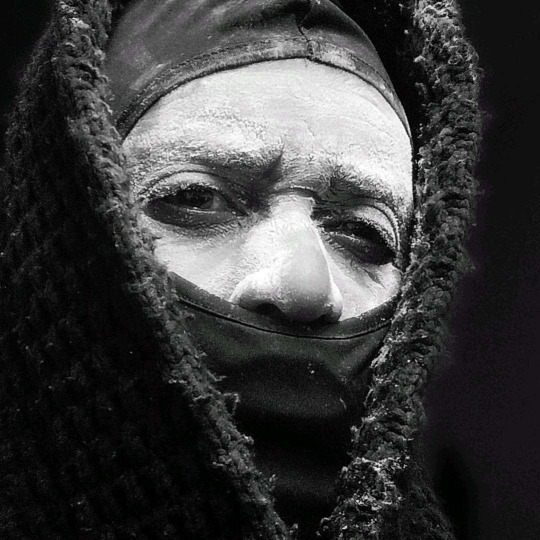
Jamaican Obeah
Jamaican Obeah refers to the practice of Obeah, a spiritual and magical tradition rooted in West African and Caribbean cultures. Obeah has a significance presence in Jamaica and holds cultural and historical importance on the island. Obeah in Jamaica has its roots in the spiritual beliefs and practices brought to the Caribbean through the transatlantic slave trade. Enslaved Africans brought with them a rich tapestry of religious and spiritual traditions, and Obeah emerged as a distinct syncretic practice in Jamaica. Individuals who practice Obeah are often referred to as "Obeah men" or "Obeah women". These practitioners have a deep understanding of the spiritual realm and are sought after for their abilities in healing, protection, divination and other spiritual services.
It's crucial to approach discussions about Jamaican Obeah with cultural sersitivity, recognizing the diversity of beliefs and practices within the Afro-Caribbean spiritual landscape. Different individuals and communities may have variations in their practices, and interpretations may differ among practioners. Respect for cultural beliefs and traditions is essential and fostering understanding.
#Obeah#Spiritual#Magical#Tradition#West African#Caribbean#Culture#History#Enslaved Africans#Syncretic Practice#Healing#Protection#Divination#Afro-Caribbean#Jamaica
94 notes
·
View notes
Text
Very interested in Wunmi characterizing Annie as - even prior to the canon events of the movie - being a “spiritual leader of the community,” and specifically how this contrasts with Jed’s very concentrated, patriarchal role as a Christian spiritual leader at Sunflower. Jed has lived in Sunflower for his entire life and teaches the dominant religious tradition of his region and historical time period, but Annie, being from New Orleans and having learned hoodoo from her grandmother, is a comparable newcomer in the community.
How many people has she helped, and how widely acknowledged is her prowess, for Annie to bypass any doubts about herself as a “newcomer,” an outsider,” an “unusual woman,” and come to be viewed as the/a spiritual leader in her community?
#drop the backstory notes Coogler ….#as I understand it hoodoo can have some syncretic practices with Christianity (with many Christians practicing it) but Annie never mentions#this influence so I think it would be odd to assume that she incorporates Christian theology into her practice.
41 notes
·
View notes
Text
Dual faith folk witches
Polish Folk Witch (on instagram and Patreon) has an excellent article on dual faith practice and syncretism among folk witches: Dual Faith: the elephant in the room of the witchcraft community. The topic of dual faith keeps returning on a regular basis in the broader witchcraft community online, especially on the intersection of folk magic, paganism and christian occultism. Folk witches often…
View On WordPress
#diversity#dual faith#dual-faith practice#dvoeverie#folk Catholicism#folk witches#noteworthy posts#occult#Pagan#Polish folk witch#practice#religious identity#spirituality#syncretism#tradition#Wicca#witchcraft
71 notes
·
View notes
Text
when reading scripture or religious texts in my studies from a variety of religions (a not-insignificant part of my education has been religious studies) i can appreciate and understand the beauty and appeal of it and make sense of its internal logic system and worldview and feel that i'm picking up what it's putting down even if i don't necessarily identify with it on a personal level, but i gotta be honest i always feel like i'm missing something or losing my mind when i read christian texts like i don't get it and it doesn't make sense to me and nothing about the trinity makes sense to me and the entire worldview feels so harsh and terrifying and bleak for no reason and every time i've asked anyone in my family (on the christian side) to explain any of it to me like sincerely i just feel more baffled and whenever i've had to read passages of the new testament i dont get it at all like even abstractly i don't understand and it makes me feel crazy like what i'm looking at has to be completely different from what other people are seeing and i don't mean it in a reddit atheist smug asshole way like it's genuinely beyond my comprehension I Don't Get It and i don't think i ever will
#and this is solely looking at texts/scripture/writings like i understand its historical and material context and aesthetics#i appreciate the way thay different ethnic groups have adapted xtianity to their culture and find it fascinating when it is syncretic#with ancient traditions and respect peoples right to practice and understand many xtian minorities have faced persecution etc#but every time i read something from the new testament im like is this really...??? uhhhh#and i dont feel that way at all w any other religions texts i can vibe with it i see what its doing and understand it and appreciate it#i find it so deeply unappealing in every possible way . truly just not for me sorry#it doesnt help the sheer amnt of bad experiences ive had with xtians targeting me for conversion#explicitly even after being told that i am sikh and not interested and continued to be harassed#and a genuinely traumatic incident w christian family counselling ive blocked out lol
50 notes
·
View notes
Text
idle curiosity: does anyone I know have any recommendations for researching Buddhism from a more practical perspective, as opposed to the often philosophical/secular one presented in a lot of English texts?
#cipher talk#Especially if you like. Grew up with Buddhism#A lot of this is because I'm trying to figure out the historically informed way to write about the way a real group may have practiced#(Therapeutae- Egyptian sect that is currently thought to have a Judeo-Buddhist syncretized religion)#(The information we have from the time says North Indian Buddhists sent emissaries into Ptolemic Egypt and Eastern Rome but we also have#A great deal of evidence that Roman Egypt traded with Tamil peoples and that possibly was a greater influence. Sri Lanka esp is mentioned)#But also I would like to learn in general
5 notes
·
View notes
Text
Currently working on a some syncretism with Hellenic Deities and creating my own personal Hellenic Pantheon. I’ll probably post some graphics once I’m done but if anyone has any direct queries my AskBox is open 🥰
#HelPol#Personal Spirituality#Personal Practice#syncretism#deity syncretism#personal pantheon#Hellenic pantheon#thewitchfarhan
2 notes
·
View notes
Text
Folk witches and dual faith
Polish Folk Witch (on instagram and Patreon) has an excellent article on dual faith practice and syncretism among folk witches: Dual Faith: the elephant in the room of the witchcraft community. The topic of dual faith keeps returning on a regular basis in the broader witchcraft community online, especially on the intersection of folk magic, paganism and christian occultism. Folk witches often…
View On WordPress
#Christianity#dual faith#dual faith practice#dvoeverie#folk witches#other people’s journeys#Paganism#Polish folk witch#spiritual wobbles#syncretism
1 note
·
View note
Text
I think it’s useful to remember that historically temples weren’t constructed by one organization to be maximally useful to as many people as possible. Communities made temples to the gods and aspects of those gods which were the most relevant to them, and those temples became centers of worship for the larger world when people who shared those interests came together to worship there. Community has to come first. And if a community doesn’t worship or practice the exact same way as you, that doesn’t mean that space isn’t a place where you can connect to the gods. Take it as an opportunity to learn new dimensions of practice or to connect with different gods.
Something that has been in the back of my mind for a while
I’ve seen a fair amount of people talk about how badly they wish there were pagan temples to go worship at and find community
And I absolutely agree that this would be an amazing thing for us
But I can’t help wondering about the logistics of it all
I’m not saying this to discourage anyone from wanting this, I just think that in order to make it happen, we need to really consider some of these questions.
In the event that we are starting to actually build pagan temples for modern worship, how exactly are they going to function?
Are we going to have the equivalent of non-denominational churches, where anyone worshipping any pantheon(s) can attend one temple?
Are we going to divide them by pantheon (so one for Hellenic paganism, one for Norse paganism, etc)?
How do we establish higher authorities within the temples (priests, priestesses, and the like)?
Will we have to standardize rituals in order to officially recognize these higher authorities? If so, what would they look like?
What would services look like within these temples, and how often would you have to go to these services?
Will these temples lean towards revivalism or reconstructionism? Will there be separate temples for each? Will they be treated equally within the same temple?
Are there codes of conduct that must be established? Will these codes of conduct differ based on pantheon?
I’m sure there are other logistical questions I’m not thinking of right now that also deserve to be taken into consideration. However, the point is that in order to make these temples a reality, we do need to establish how they’ll function.
I don’t expect any one person to have all the answers, but if anyone has any idea how we could make this work, feel free to share your thoughts.
And again, I don’t want this to come across as discouragement, or in any way negative. I’m just pondering and figured I’d share my ponderings with paganblr.
#when in Rome do as the Romans do#in the most literal sense#this is what made syncretism and religious exchange so beautifully fluid#people would practice differently at different temples#and traveling to new areas would expose them to new varieties of praxis#paganism#paganblr#hellenic pagan#hellenic polytheism
22 notes
·
View notes
Text
I do have to say one thing about a particular scene in "Sinners" that was another red flag about Remmick's intentions....
*spoilery things ahead*
I couldn't get over how insidious it was of him to use our ring-shout ceremony to force-assimilate the Black juke joint folks into his little vampire cabal.
That clockwise and counterclockwise dancing in a circle is so powerful for us. We did it in Congo Square, among the Geechee/Gullah in the low country, and elsewhere. It is the place of communing with spirits to put us in a trance-like state to open that doorway. We use it in Hoodoo, Voodoo, Candomble, Obeah and other syncretic religious off-shoots that we've created and used throughout the Black Diaspora to bind us with our ancestors and call down our Gods/Orishas/Loas to often ride us like horses.
For him to use our most intimate way to connect with our own for his nefarious use--forcing us to dance to his music, and sing HIS Irish songs--offended me the best way in a movie. Ryan did his homework! I almost shouted in the theater, "Oh, no this dude did not just use our cultural practices to uplift him and his own. Tricking them into thinking they were the same."
Anyhoo, shout out to the ring-shout. The details in this fucking movie still blow me away. The ring-shout dancing is liberation for us and often had be done hidden away in the woods. Watching it used to enslave Black people again was intense.
Sidenote: Jack O'Connell was dancing his ass off and I'm so happy he got to get back into his Irish dancing roots himself! Somebody throw on Beyonces "Riverdance"! Lol!


235 notes
·
View notes
Note
...What's Judeo-Dionysus theory?
Inside joke with some theology friends. A few years ago one of us found an article about how supposedly, there was a Interpretatio graeca of
Ancient Greek Guy Voice: "just met these Jewish folks, their religion involves a lot of wine and a god with a secret name, so we figure they worship Dionysus."
Now, none of us have actually been able to find this damn article, so we are pretty sure it's made up. In real life, Geeco-Roman religion and Judaism obviously interacted and syncretized, but we liked the idea that the interaction went something along the lines of:
Ancient Greek Guy: "Yoo I dig your weird cult of Dionysus."
Ancient Jewish Guy: "Yooo I dig your weird temple to Hashem."
Both of them are the same time: "Nice to meet someone who practices the same religion I do!" And they were best friends forever.
2K notes
·
View notes
Text
The Gods we can celebrate on Sabbats 🛞
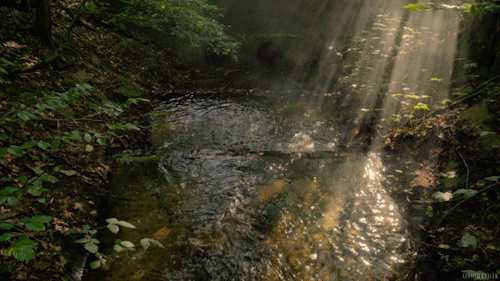
As a dodecatheist Hellenist, it's important for me to follow the practices of the ancient Greeks. However, paganism offers us the freedom of syncretism.
So, while the Wheel of the Year is first and foremost Celtic and Wiccan, it's close to my heart because it celebrates the power of nature.
So here's a list of the different Sabbats and the Greek gods associated with them, which we can celebrate.
Samhain : Hecate, Demeter, Persephone, Psyche, Hades, Hermes, Dionysus.
Yule : Aphrodite, Gaia, Demeter, Alcyone, Tyche, Apollo, Helios, Dionysus.
Imbolc : Aphrodite, Gaia, Demeter, Artemis, Hestia, Persephone, Athena, Eros, Pan.
Ostara : Aphrodite, Gaia, Demeter, Persephone, Pan, Apollo.
Beltane : Artemis, Hera, Aphrodite, Gaia, Apollo.
Litha : Hestia, Tyche, Nike, Demeter, Athena, Apollo, Hephaestus, Zeus.
Lughnasadh : Aphrodite & Adonis (aphrodisia), Athena (panathenaia), Demeter, Tyche, Hera, Hestia, Hephaestus, Apollo, Zeus.
Mabon : Demeter, Demeter & Kora (Eleusis), Tyche, Gaia, Dionysus, the death of Adonis, Hermes.
420 notes
·
View notes
Text
Polytheist & Pagan Asks
🙏 - Which pantheon(s) do you actively worship?
🌞 - Which deity(ies) are you closest to/do you worship the most often?
✨ - Do you believe in patron deities? If so, do you have any that you know of?
🌍 - Which pantheons do you believe exist?
📜 - Have you ever made an oath, vow, or contract with a deity? If yes, how did it go (you don't have to share)?
📿 - What are three things you're grateful to your deity(ies) for?
🖋️ - If you could say anything to your deity(ies) right now, what would you most want to say?
💌 - What is your favorite form of deity communication?
🎭 - What is an emotionally impactful or a silly worship-related experience you've had?
❤️ - What's one memory of your practice that you reflect the most fondly on?
🥂 - What is your favorite devotional act or offering to give?
🎉 - Do you celebrate any festivals? If so, which ones?
🫂 - Do you syncretize any pantheons with one another? If so, which ones?
🔮 - Do you delve into topics like the occult or the mysteries? Do you do anything esoteric?
⭐ - What is something you wish people outside your practice knew more about?
📖 - Do you like the way your pantheon is most often portrayed in media? Why or why not?
🏛️ - Do you have a favorite statue or temple to your deity(ies)? If yes, what is it?
🔥 - Do you have a favorite myth or tale from your pantheon or others?
🧭 - What led you to your practice?
🧿 - Did you have any other spiritual beliefs before discovering your current practice?
🪽 - Do you believe in angels and/or demons? If yes, do you worship or work with any?
🪄 - Do you practice witchcraft? If yes, do you keep it separate from your deity worship?
🪦 - Do ancestors or human spirits play a big role in your practice?
🐾 - Do animal spirits play a big role in your practice?
🌱 - Does nature - plants, nature spirits, etc. - play a big role in your practice?
💀 - Do you believe in ghosts? If yes, have you ever had an experience with one?
☄️ - Do you believe in astral travel/the astral realm? If so, have you been there before?
2K notes
·
View notes
Text
Book Review: The Witch's Art of Incantation, 2nd ed. by Roger J. Horne

10/10, I'd buy again for what it is: but you should know what it is before you buy it
This is a review of the second edition, which is about 100 pages longer than the original and contains 55 additional incantations.
What's it about?
This is a book of translated and edited historical and folk incantations to be used in syncretic folk witchcraft or any form of witchcraft. These incantations are grouped into 9 categories:
Seeking the Old Ones
Calling to the Green World
Love and Spurned Love
Coinage and Prosperity
Curses and Maledictions
Spirit Flight and Second Sight
Blessings and Benedictions
Heretical Psalmistry
Miscellaneous latinate charms
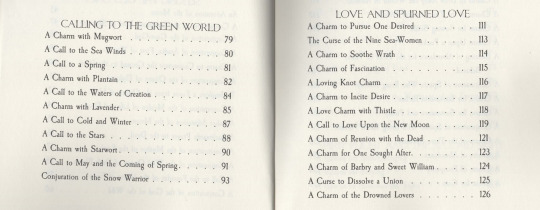
Besides a brief introduction, the book is just incantations.
It's not a spellbook. It doesn't tell you to collect candles or herbs, or what day of the week to work them on, or the moon phase, or whatever. Just as it says on the tin, it's a book of incantations.
However, Horne does have a very handy section at the beginning called Approaches to the Art of Incantation.
Here he describes methods and techniques to help empower incantations (I recommend not skipping it), a framework for understanding the power of words, and folk magic actions that may be combined with incantations, such as the burning of candles with pins stuck in, or speaking over poppets.
If you've skipped Folk Witchcraft, definitely check out this section.
(As Horne explains in the introduction, the first ed. of this book was a companion book to his other text, Folk Witchcraft. Apparently, Folk Witchcraft provided a great deal of context and lore surrounding the use of the incantations themselves.
The second ed. has been developed into a standalone text, but Horne still recommends looking to Folk Witchcraft if you want more context.)
Where do these incantations come from?
Horne makes it clear that he primarily sourced incantations from Europe and America (primarily Appalachia) not because they're particularly better in any way, but because these are the areas his ancestors and practice stem from. He makes an outspoken statement against any perceived Eurocentric authority, and warns people to not take his area of focus to mean there is more power within those cultures than within others.
That being given, these incantations are sourced historically from at least the first century onward, from a wide variety of sources, including Greco-Roman, Irish, Scottish, Cornish, Welsh, French, German, Appalachian, Icelandic, and more.
When possible, Horne notes where the incantation originated from, and in what manner he edited it.
All of these incantations have been edited for use by the modern reader; they are Horne's original adaptations. This is not a historical reference.
An example?
To give you an idea of the contents, this is one of the shorter incantations in the book, "A Call to Fire."
A Call to Fire Fire untamed, lustrous, and bright, power behind the sun, moon and every star. Aetherial fire, source of life, most splendid flower, heat-bringer, light-bringer, hear me, radiant fire. [Origin: 3 BC - 1 AD. Greco-Roman. Adapted and rearranged with poetic license after The Hymns of Orpheus. pg. 100.]
This incantation may be used to charm offering candles, to consecrate sacred fires, to call forth salamanders or fire elementals, to honor a god or spirit of fire, and so forth - the application is up to you.
Is the variety solid? Are they versatile enough for use even if you don't consider yourself to be a folk witch?
A big reason I recommend this book so highly isn't just because it's handy for me, but because I think it is very versatile.
The variety of what's presented is exceptional; there are charms to hail the seasons and the moons, the Old Ones and plant allies, to cure grief and wrath, to call a lover, to steal wealth, to conjure all varieties of helpful spirits, to reveal a thief, to hag-ride, to skin-change, to induce second-sight, to charm your cards for better readings, and I could go on and on.
In addition, because Horne sources everything where he can, it's a wealth to look not only at his adaptations but compare the charms to the historical originals, and thereby gain inspiration for developing your own incantations.
The best part for me is that they're all usable. It's not a spellbook where you can't get some ingredients so you can't use some spells. They're incantations that you pair with whatever spell elements you want to include, including just using them on their own.
But are they sexy? Will I feel like I'm living deliciously?
Yes. You will feel like you are living deliciously. You will feel like ye olde wytche who feeds blood and honey to their familiar, and steals the potency of men at night as you roam in your second skin; you will believe you may only be harmed with a silver bullet when you take the form of a hare to rob milk from cows.
Real quick, what's up with those 'heretical psalms' and latinate charms?
The last (and smallest) portion of the book more heavily leans into syncreticism. Horne's attitude in the book is that folk witchcraft is by practicality and oftentimes necessity a syncretic one, and that witches use what's on hand in order to get the job done. He references the importance of the influence of the Church on modern cunning traditions, including both the adoption of psalms and also of latinate language.
Twenty-three psalms are printed in the book along with recommended magical uses, along with a list of the magical uses of psalms (which you'd have to look up yourself).
Finally, Horne has a fifteen incantations in Latin. Or, latinate, as he keeps clarifying. He hasn't taken charms and translated them into Latin, rather he's edited historical folk charms that were recited in liturgical Latin by the people who used them - again emphasizing syncreticism in folk magic.
If you're not into Christian syncreticism, I doubt this section would be of use to you. This section constitutes 80 total pages out of 319, or about a quarter of the book. Personally I'd still get it for the more pagan incantations even if I didn't want the more syncretic ones, but it's certainly not to everyone's tastes.
(Be advised that there is a lot of Scottish folk magic in this book, plenty of which calls on Mary as divine authority. Obviously you can change the incantations as you please, but if you're allergic to these things, be aware they are peppered throughout the text.)
Chicken, who would you personally recommend this book to?
I would recommend this book to a practitioner who is:
Ready to start seriously investing in their personal repertoire of spells
Confident enough to experiment with spellcrafting
Sick and tired of spellbooks that recommend inaccessible ingredients, and just want building blocks to make their own full-format spells
Wanting a resource that helps with getting practical magic done within their current paradigm, without having to adopt a lot of new ritual aspects or theories
Looking for inspiration to expand their current practice without having to restart their practice
Looking for resources on Christian or heretical witchcraft
Anyone seeking resources on the power of words in practical sorcery
I'm a pagan, not a witch, and I love hymns and incantations. Would I like it?
To be honest, I doubt it.
Yes, the book starts with incantations to the Old Ones, who are ostensibly gods; but anyone with an eye to see can tell that the incantations all either relate to the Devil or the Queen of Witches. Also, one for Fenris ("darkling wolf") and one for the Sun.
Like 5 of the incantations may clearly be associated with Greek gods, but those gods are not named and the association appears to be selected based on their relevance to witchcraft.
A vast majority of all incantations in the book are related to spellwork and conjuring nature spirits. These incantations were designed for use in magic, which includes calling spirits and compelling action; not so much veneration or worship.
Readability and Accessibility
The physical quality of the book is disappointing. And that's not the author's fault and has no bearing on the actual contents, but right out of the box I was afraid the poor thing was going to fall apart. However it was cheap as hell so I have nothing to complain about, this thing was like $15 for a paperback. It has the quality you would expect from such a cheap purchase.
The text is sort of an artsy one? It's a serif font that's not too out there, but it's smaller than I was expecting, and my eyes don't love it. You will have to find your reading glasses for this one. All his books I bought are published in this typeface so I assume it's a choice.
Horne loves big paragraphs and long sentences. I find his writing style to be clear and easy to follow, but it's not a lower grade reading level. You may expect a maximum of two paragraphs per page in the prose portions.
The incantations themselves are broken up into much more manageable parts, always containing no more than 2 lines per paragraph break.
I believe Horne did this on purpose to compel the reader to find their own cadence in the incantations. But, it has the added effect of contributing to readability. The way each incantation is split up makes it very easy to follow and not lose your place.
6/10 for physical manufacture; I really wish the typeface was less artsy and more standard, but I could still read it through, especially once I got used to it.
#book review#witchblr#witch community#the witch's art of incantation#roger j horne#long#long text#witchcraft#witch books#windvexer book review
298 notes
·
View notes
Text
nope just saw it "actually easter comes from the germanic goddess-"
I'm gonna stop you there and make you look me in the eyes and tell me a holiday originating in the middle east was """""stolen"""" from folks in northern Europe, say it with a straight face and mean it. I won't belive you bc its bullshit, but damn.
of course Christianity has done irreparable harm to cultures and religious and spiritual practices globally. but let's use our critical thinking skills when talk about it to consider weather or not it's crackpot racism from the 70s or maybe true.
how is Easter two days away and I have to hear about Christimas being "stolen" from pegans.
#chriatian learders almsot certinly did not steal this that or the other thing from anyone#far more likely is folks folded their traditions and practices into Christianity to keep them alive#which is a seperate type of oppression#but one which gives the victims agency which claims of tradtions being stolen denies them#christians dont steal traditions that not how it works#[historically we dont need to get into how chratians are stealing jewish traditions currently thats a seprate thing]#historically if christians want you to be Christian you convert or you die OR your children are stolen and converted#ie: the spanish inquisition and residental schools#however if you look at mexican catholisism iriah catholisism and polish catholisism you have three very different cultures#bc after conversion people kept their cultures and spritual practices alive by folding them into the opressors culture#with the exeption of “easter was named after this goddes from NORTHERN EUROPE” “x tradition was stolen from pegans” is probably actually#“pegans continued to practice theirculture despite having become christian”#its a whole seperate type of opression -- cultural syncretism
3 notes
·
View notes
Text
Pagan syncretism is the best. I love being able to worship whomever, whenever. I love being able to study occultism from around the world and put together a practice that is so unique and special to me. I love being able to worship gods from ancient societies like Greece. I love the even more ancient gods from Egypt. And we can go back further and revive the gods from Sumer! I love honoring spirits of the sun, and moon, of death, and love. I love being playful with the faeries, soaring with dragons, and meditating with bodhisattvas. If it is open to me, I am willing to learn and boy has it enriched my life tenfold! I don’t ever want to stop!
#pagan#paganism#hellenic deities#hellenic devotion#polytheism#omnism#animism#syncretism#dragons#faeries#faery witch#faerie#fae folk#bodhisattva#meditation#mesopotamian deities#kemetic#egyptian deities#greek gods#shinto#buddah
461 notes
·
View notes
Text
2,000-Year-Old Fayum Portraits from Roman Egypt: also known as "mummy portraits," these funerary paintings were often fastened to the coffins of the people they depicted

Above: Fayum portrait of a woman from Roman-occupied Egypt, c.100-110 CE
Fayum portraiture was a popular funerary practice among the upper-class families of Roman Egypt from about 50 CE to 250 CE. Given the high mortality rates for children during this period, many of these portraits depict children and youths, but adults were often featured, too.
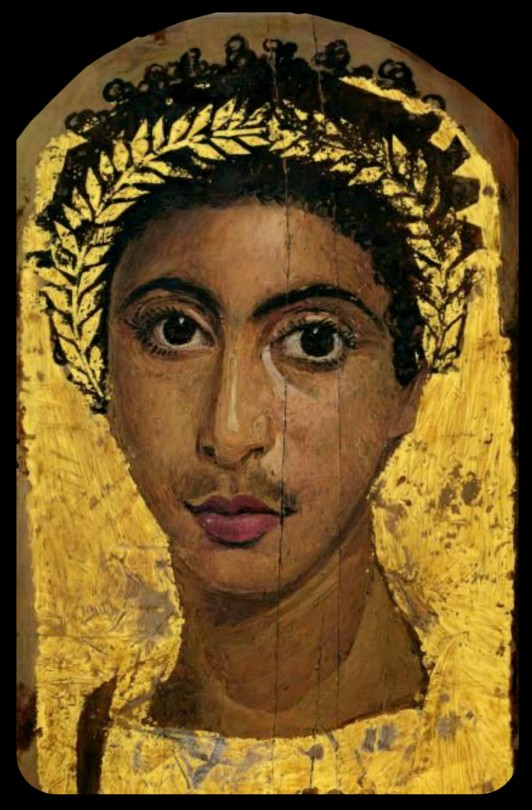
Above: portrait of a youth wearing a golden wreath, c.130-150 CE; the wreath and the background of the portrait are both gilded
The population of the Faiyum Delta, where most of these portraits were found, largely contained individuals with both native Egyptian/North African and Greek heritage. The Greek lineages can be traced back to the Ptolemaic period, when the Greeks gained control of Egypt and began to establish settlements throughout the region, gradually leading to a cultural diffusion between the Greek and Egyptian populations. The Romans eventually took control of Egypt in 31 CE, absorbing it into the Roman Empire and colonizing much of North Africa, but the demographics of the Faiyum Delta remained largely unchanged.

Above: portrait of a man with a mole on his nose, c.130-150 CE
Many of these Fayum portraits reflect the same blend of ethnic and cultural roots, depicting individuals with both Greek and native Egyptian heritage (a claim that is supported by both archaeological and genetic evidence). Some portraits may also depict native Egyptians who did not have any European ancestry, but had been integrated into Greco-Roman society.

Above: portrait of a bearded man, c.170-180 CE
These representations of native Egyptians provide us with unique insights into the actual demographics of Roman-occupied Egypt (and the ancient world at large). Non-European peoples are rarely included in depictions of the classical world; it's also interesting to see the blend of cultural elements that these portraits represent.
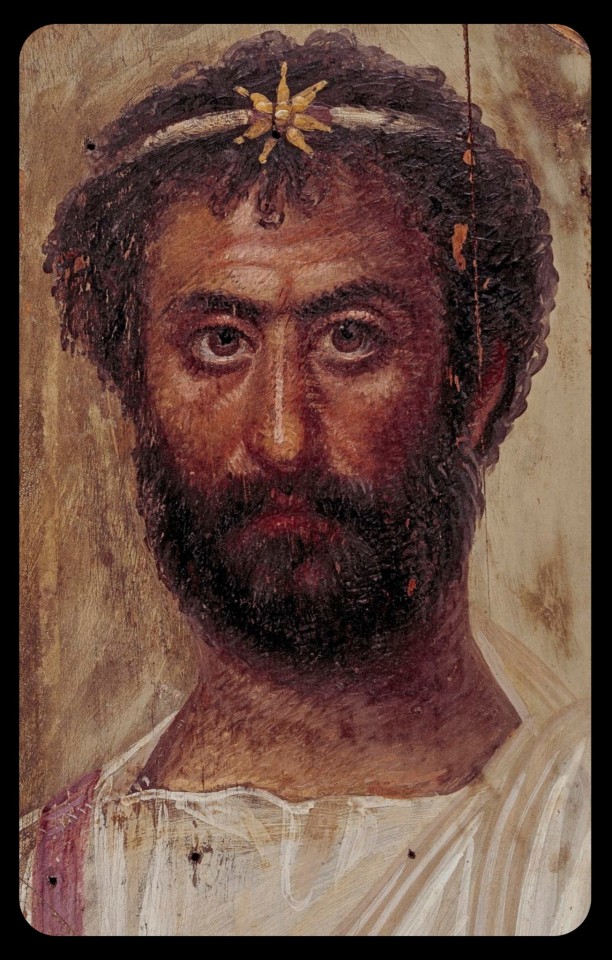
Above: portrait of a priest of Serapis, c.140-160 CE; the man in this portrait is shown wearing a fillet/crown that bears the seven-pointed star of the Greco-Egyptian god, Serapis
As this article explains:
In the 1800s and early 1900s, Western art historians didn’t know what to make of these portraits. Scholars of Roman history labeled them Egyptian. Scholars of Egyptian history labeled them Greco-Roman. These binary academic classifications failed to capture the true complexity of the ancient (or, indeed, modern) Mediterranean. In reality, Fayum portraits are a syncretic form, merging Egyptian and Greco-Roman art and funerary practices. They reflect the cosmopolitanism of both Roman and Egyptian history.

Above: portrait of a man, c.80-100 CE (left); portrait of a bearded officer, sometimes referred to as "Perseus," c.130-175 CE (right)
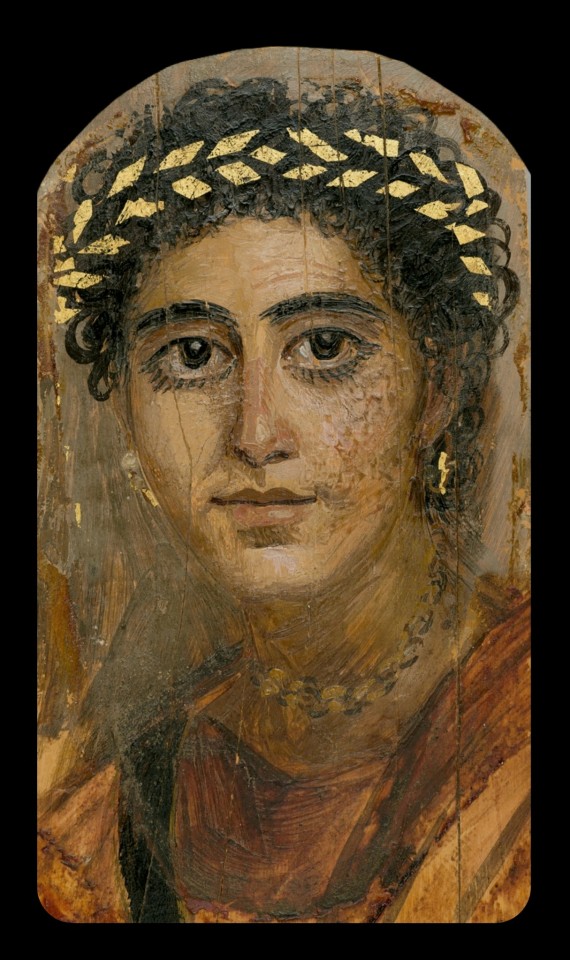
Above: portrait of a young woman in red, c.90-120 CE
Nearly 1,000 of these portraits are currently known to exist.
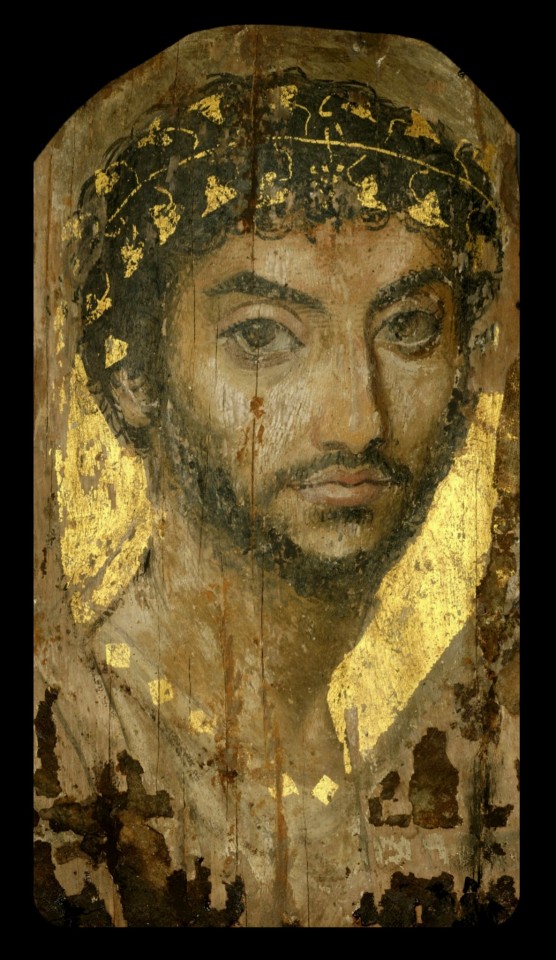
Above: portrait of a man wearing a gilded ivy wreath, c.100-150 CE
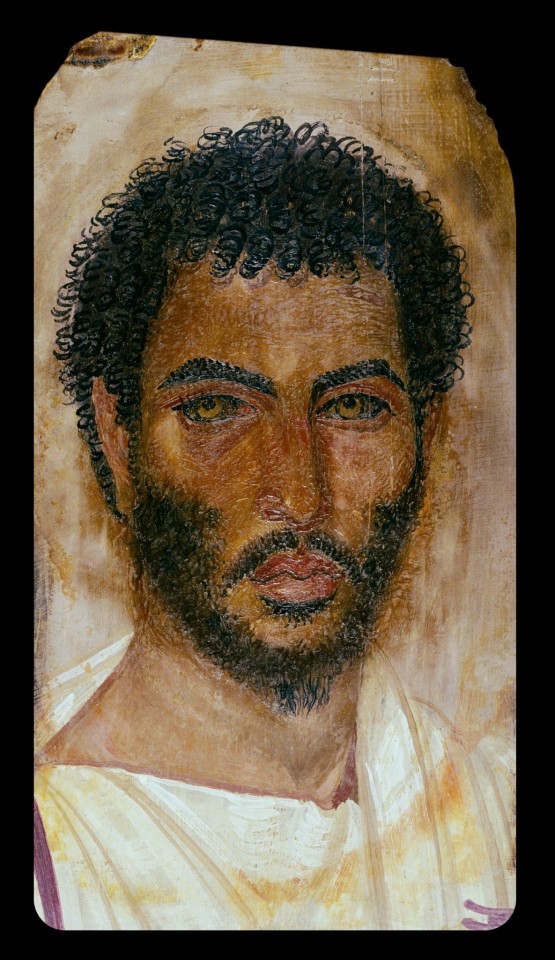
Above: portrait of a bearded man, c.150-170 CE
Sources & More Info:
Curationist: Fayum Portraits
Harvard Art Museums: Giving the Dead their Due: an Exhibition Re-Examines Funerary Portraits from Roman Egypt
Getty Museum: APPEAR Project
Getty Museum: Faces of Roman Egypt
National Geographic: Ancient Egypt's Stunning, Lifelike Mummy Portraits
The Athens Centre: The Myth of Whiteness in Classical Sculpture
Forbes: Whitewashing Ancient Statues: Whiteness, Racism and Color in the Ancient World
#archaeology#artifact#anthropology#history#ancient history#art#fayum portraits#roman egypt#ancient rome#ethnography#painting#portrait#north africa#people of color#egypt#religion#greco roman#greek#classical antiquity#fayum#mummy portraits#romano egyptian#representation
461 notes
·
View notes